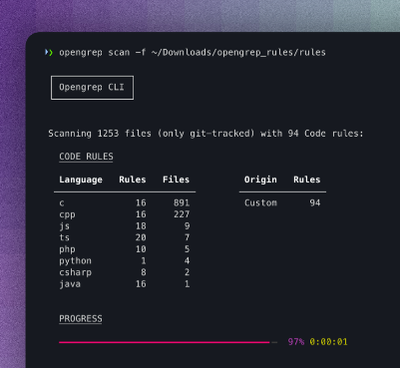
Security News
Opengrep Emerges as Open Source Alternative Amid Semgrep Licensing Controversy
Opengrep forks Semgrep to preserve open source SAST in response to controversial licensing changes.
github.com/aquasecurity/tracee/libbpfgo
libbpfgo is a Go library that allows working with the Linux eBPF subsystem via libbpf. libbpf is a C library that's developed as part of the Linux kernel tree which provides an accessible layer of abstraction on top of the raw eBPF system APIs. libbpfgo is just a thin wrapper in Go around libbpf.
libbpfgo is using CGO to interop with libbpf and will expect to be linked with libbpf at run or link time. Simply importing libbpfgo is not enough to get started, and you will need to fulfill the required dependency in one of the following ways:
libbpfgo tries to make it natural for Go developers to use, by abstracting away C technicalities. For example, it will translate low level return codes into Go error, it will organize functionality around Go struct, and it will use channel as to let you consume events.
In a high level, this is a typical workflow for working with the library:
Module struct - that is a unit of BPF functionality around your compiled object file.BPFProg struct.BPFProg to system facilities, for example to "raw tracepoints" or "kprobes" using the BPFProg's associated functions.BPFMap struct and it's associated methods.PerfBuffer struct and it's associated objects.// initializing
import bpf "github.com/aquasecurity/tracee/libbpfgo"
...
bpfModule := bpf.NewModuleFromFile(bpfObjectPath)
bpfModule.BPFLoadObject()
// maps
mymap, _ := bpfModule.GetMap("mymap")
mymap.Update(key, value)
// perf buffer
pb, _ := bpfModule.InitPerfBuf("events", eventsChannel, lostEvChannel, buffSize)
pb.Start()
e := <-eventsChannel
There are many more methods supported and functionality available. We will be documenting this library more extensively in the future, but in the meantime, you can take a look at the libbpf_wrapper.go code to get an idea of what's possible, or look at the Tracee code as a consumer of this library, or just ask us by creating a new Discussion and we'd love to help.
FAQs
Unknown package
Did you know?

Socket for GitHub automatically highlights issues in each pull request and monitors the health of all your open source dependencies. Discover the contents of your packages and block harmful activity before you install or update your dependencies.

Security News
Opengrep forks Semgrep to preserve open source SAST in response to controversial licensing changes.

Security News
Critics call the Node.js EOL CVE a misuse of the system, sparking debate over CVE standards and the growing noise in vulnerability databases.

Security News
cURL and Go security teams are publicly rejecting CVSS as flawed for assessing vulnerabilities and are calling for more accurate, context-aware approaches.